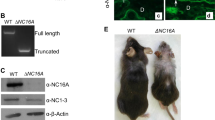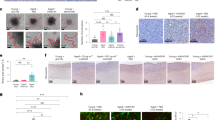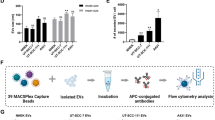Abstract
Coculture of human melanocytes with keratinocytes upregulates CCN3, a matricellular protein critical to maintenance of normal homeostasis of melanocytes in the skin. CCN3 affects two fundamental features of melanocyte physiology: it inhibits melanocyte proliferation and stimulates their adhesion to the basement membrane. Here we report that expression of CCN3 is downregulated in advanced melanomas. Aggressive melanoma cell lines did not respond to treatment with CCN3 inducers, such as interleukin-1β (IL-1β), while less aggressive melanoma cell lines responded similarly to melanocytes. Immunostaining analyses revealed that CCN3 was present in melanoma cells close to the epidermal–dermal interface, but not in melanoma cells that had invaded deep into the dermis or had metastasized to lymph nodes. Contrary to our expectations, overexpression of CCN3 in 1205Lu metastatic melanoma cells did not affect their adhesion to collagen IV. However, CCN3 decreased the transcription and activation of matrix metalloproteinases and suppressed the invasion of 1205Lu melanoma cells. These results suggest that the lack of CCN3 in advanced melanoma cells contributes to their invasive phenotype. Whereas major matricellular proteins, such as osteopontin, tenascin or secreted protein acidic and rich in cysteine (SPARC), are strongly upregulated in melanoma cells; CCN3 is the first member of this family that is downregulated.
This is a preview of subscription content, access via your institution
Access options
Subscribe to this journal
Receive 50 print issues and online access
$259.00 per year
only $5.18 per issue
Buy this article
- Purchase on Springer Link
- Instant access to full article PDF
Prices may be subject to local taxes which are calculated during checkout




Similar content being viewed by others
References
Benini S, Perbal B, Zambelli D, Colombo MP, Manara MC, Serra M et al. (2005). In Ewing's sarcoma CCN3(NOV) inhibits proliferation while promoting migration and invasion of the same cell type. Oncogene 24: 4349–4361.
Breslow A . (1970). Thickness, cross-sectional areas and depth of invasion in the prognosis of cutaneous melanoma. Ann Surg 172: 902–908.
Clark WH . (1991). Tumour progression and the nature of cancer. Br J Cancer 64: 631–644.
Denkert C, Siegert A, Leclere A, Turzynski A, Hauptmann S . (2002). An inhibitor of stress-activated MAP-kinases reduces invasion and MMP-2 expression of malignant melanoma cells. Clin Exp Metastasis 19: 79–85.
Fukunaga-Kalabis M, Martinez G, Liu ZJ, Kalabis J, Mrass P, Weninger W et al. (2006). CCN3 controls 3D spatial localization of melanocytes in the human skin through DDR1. J Cell Biol 175: 563–569.
Gilles C, Bassuk JA, Pulyaeva H, Sage EH, Foidart JM, Thompson EW . (1998). SPARC/osteonectin induces matrix metalloproteinase 2 activation in human breast cancer cell lines. Cancer Res 58: 5529–5536.
Glukhova L, Angevin E, Lavialle C, Cadot B, Terrier-Lacombe MJ, Perbal B et al. (2001). Patterns of specific genomic alterations associated with poor prognosis in high-grade renal cell carcinomas. Cancer Genet Cytogenet 130: 105–110.
Gupta N, Wang H, McLeod TL, Naus CC, Kyurkchiev S, Advani S et al. (2001). Inhibition of glioma cell growth and tumorigenic potential by CCN3 (NOV). Mol Pathol 54: 293–299.
Haass NK, Smalley KS, Herlyn M . (2004). The role of altered cell–cell communication in melanoma progression. J Mol Histol 35: 309–318.
Haass NK, Smalley KS, Li L, Herlyn M . (2005). Adhesion, migration and communication in melanocytes and melanoma. Pigment Cell Res 18: 150–159.
Herlyn M, Graeven U, Speicher D, Sela BA, Bennicelli JL, Kath R et al. (1991). Characterization of tenascin secreted by human melanoma cells. Cancer Res 51: 4853–4858.
Hofmann UB, Westphal JR, Waas ET, Zendman AJ, Cornelissen IM, Ruiter DJ et al. (1999). Matrix metalloproteinases in human melanoma cell lines and xenografts: increased expression of activated matrix metalloproteinase-2 (MMP-2) correlates with melanoma progression. Br J Cancer 81: 774–782.
Hsu MY, Shih DT, Meier FE, Van Belle P, Hsu JY, Elder DE et al. (1998). Adenoviral gene transfer of beta3 integrin subunit induces conversion from radial to vertical growth phase in primary human melanoma. Am J Pathol 153: 1435–1442.
Hsu MY, Wheelock MJ, Johnson KR, Herlyn M . (1996). Shifts in cadherin profiles between human normal melanocytes and melanomas. J Investig Dermatol Symp Proc 1: 188–194.
Kalembeyi I, Inada H, Nishiura R, Imanaka-Yoshida K, Sakakura T, Yoshida T . (2003). Tenascin-C upregulates matrix metalloproteinase-9 in breast cancer cells: direct and synergistic effects with transforming growth factor beta1. Int J Cancer 105: 53–60.
Kleer CG, Zhang Y, Pan Q, Merajver SD . (2004). WISP3 (CCN6) is a secreted tumor-suppressor protein that modulates IGF signaling in inflammatory breast cancer. Neoplasia 6: 179–185.
Kuphal S, Bauer R, Bosserhoff AK . (2005). Integrin signaling in malignant melanoma. Cancer Metastasis Rev 24: 195–222.
Lake AC, Bialik A, Walsh K, Castellot Jr JJ . (2003). CCN5 is a growth arrest-specific gene that regulates smooth muscle cell proliferation and motility. Am J Pathol 162: 219–231.
Laurent M, Martinerie C, Thibout H, Hoffman MP, Verrecchia F, Le Bouc Y et al. (2003). NOVH increases MMP3 expression and cell migration in glioblastoma cells via a PDGFR-alpha-dependent mechanism. FASEB J 17: 1919–1921.
Maillard M, Cadot B, Ball RY, Sethia K, Edwards DR, Perbal B et al. (2001). Differential expression of the ccn3 (nov) proto-oncogene in human prostate cell lines and tissues. Mol Pathol 54: 275–280.
Manara MC, Perbal B, Benini S, Strammiello R, Cerisano V, Perdichizzi S et al. (2002). The expression of ccn3(nov) gene in musculoskeletal tumors. Am J Pathol 160: 849–859.
Massi D, Franchi A, Borgognoni L, Reali UM, Santucci M . (1999). Osteonectin expression correlates with clinical outcome in thin cutaneous malignant melanomas. Hum Pathol 30: 339–344.
Matic M, Evans WH, Brink PR, Simon M . (2002). Epidermal stem cells do not communicate through gap junctions. J Invest Dermatol 118: 110–116.
McCallum L, Price S, Planque N, Perbal B, Pierce A, Whetton AD et al. (2006). A novel mechanism for BCR-ABL action: stimulated secretion of CCN3 is involved in growth and differentiation regulation. Blood 108: 1716–1723.
Nguyen N, Kuliopulos A, Graham RA, Covic L . (2006). Tumor-derived Cyr61(CCN1) promotes stromal matrix metalloproteinase-1 production and protease-activated receptor 1-dependent migration of breast cancer cells. Cancer Res 66: 2658–2665.
Perbal B . (2001). NOV (nephroblastoma overexpressed) and the CCN family of genes: structural and functional issues. Mol Pathol 54: 57–79.
Perbal B, Brigstock DR, Lau LF . (2003). Report on the second international workshop on the CCN family of genes. Mol Pathol 56: 80–85.
Philip S, Bulbule A, Kundu GC . (2001). Osteopontin stimulates tumor growth and activation of promatrix metalloproteinase-2 through nuclear factor-kappa B-mediated induction of membrane type 1 matrix metalloproteinase in murine melanoma cells. J Biol Chem 276: 44926–44935.
Planque N, Long Li C, Saule S, Bleau AM, Perbal B . (2006). Nuclear addressing provides a clue for the transforming activity of amino-truncated CCN3 proteins. J Cell Biochem 99: 105–116.
Robert G, Gaggioli C, Bailet O, Chavey C, Abbe P, Aberdam E et al. (2006). SPARC represses E-cadherin and induces mesenchymal transition during melanoma development. Cancer Res 66: 7516–7523.
Satyamoorthy K, DeJesus E, Linnenbach AJ, Kraj B, Kornreich DL, Rendle S et al. (1997). Melanoma cell lines from different stages of progression and their biological and molecular analyses. Melanoma Res, (7 Suppl 2): S35–S42.
Seftor RE, Seftor EA, Hendrix MJ . (1999). Molecular role(s) for integrins in human melanoma invasion. Cancer Metastasis Rev 18: 359–375.
Tanimura S, Asato K, Fujishiro SH, Kohno M . (2003). Specific blockade of the ERK pathway inhibits the invasiveness of tumor cells: down-regulation of matrix metalloproteinase-3/-9/-14 and CD44. Biochem Biophys Res Commun 304: 801–806.
Welch DR, Sakamaki T, Pioquinto R, Leonard TO, Goldberg SF, Hon Q et al. (2000). Transfection of constitutively active mitogen-activated protein/extracellular signal-regulated kinase kinase confers tumorigenic and metastatic potentials to NIH3T3 cells. Cancer Res 60: 1552–1556.
Zhou Y, Dai DL, Martinka M, Su M, Zhang Y, Campos EI et al. (2005). Osteopontin expression correlates with melanoma invasion. J Invest Dermatol 124: 1044–1052.
Acknowledgements
We thank Kate M Belser for technical assistance. This work was supported by grants from the National Institutes of Health (CA76674, CA80999, CA47159, CA76674, CA25874 and CA10815) and was partially supported by funds from the Commonwealth Universal Research Enhancement Program, Pennsylvania Department of Health.
Author information
Authors and Affiliations
Corresponding author
Additional information
Supplementary Information accompanies the paper on the Oncogene website (http://www.nature.com/onc).
Supplementary information
Rights and permissions
About this article
Cite this article
Fukunaga-Kalabis, M., Martinez, G., Telson, S. et al. Downregulation of CCN3 expression as a potential mechanism for melanoma progression. Oncogene 27, 2552–2560 (2008). https://doi.org/10.1038/sj.onc.1210896
Received:
Revised:
Accepted:
Published:
Issue Date:
DOI: https://doi.org/10.1038/sj.onc.1210896
Keywords
This article is cited by
-
Nephroblastoma overexpressed protein (NOV) enhances 5-Fu-mediated inhibitory effect of colorectal cancer cell proliferation via JNK/AP-1/caspase-8/caspase-3 pathway
Discover Oncology (2021)
-
Proteomics pinpoints alterations in grade I meningiomas of male versus female patients
Scientific Reports (2020)
-
CCN3 suppresses TGF-β1-induced extracellular matrix accumulation in human mesangial cells in vitro
Acta Pharmacologica Sinica (2018)
-
Periostin is required for matricellular localization of CCN3 in periodontal ligament of mice
Journal of Cell Communication and Signaling (2017)
-
Huaier restrains proliferative and invasive potential of human hepatoma SKHEP-1 cells partially through decreased Lamin B1 and elevated NOV
Scientific Reports (2016)



